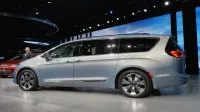Why Chrysler made the Pacifica Hybrid

“This could be a primary electric vehicle for someone.”
We started with the big question: why build a plug-in minivan at all? “It brings the ability that if you want an electric vehicle, a hybrid, you don’t have to compromise size to get there,” Mets said. “For instance just a few minutes ago I was talking to someone from Canada and they were saying in the US it’s two vehicles per household is kind of the norm. In Canada it’s not that way, it’s more like a vehicle or even less than a vehicle. There’s a lot of people that want an electrical vehicle in Canada but they can’t make it their primary vehicle. This is a vehicle that could be a primary electric vehicle for someone in Canada, or anybody else for that matter, who wants a plug-in vehicle, an electric vehicle that doesn’t have to compromise in size.”
So, was the development of the Pacifica PHEV influenced more by customers saying they wanted a plug-in hybrid minivan or was it driven more by green vehicle regulations? “That’s a tough one to answer,” Mets said. “Certainly you have to meet all the requirements. There’s a little bit of everything there. You also can pick what vehicles you want to do it on. You pick which vehicle is the best opportunity and this is the one we chose. It’s a little bit of both.”
As for when the Pacifica Hybrid will reach dealerships, all we know is, “late 2016.” But Mets said that the minivan will at some point be available in all 50 states. Initial availability might be limited to places like California, but, “The idea is to sell it nationwide,” he said.
Chrysler decided on the “Pacifica Hybrid” name instead of the more-accurate “Pacifica Plug-In Hybrid” for simplicity. Anyone who might care that the minivan plugs in will find out that it, indeed, has a plug, the reasoning goes, but when Chrysler talks to the average mass market shopper, “hybrid” tells them everything they need to know.

Under the hood (and the floorboards, where the batteries are) there are a lot of new bits. Mets said that the transmission is all new and the engine is the new 3.6-liter Pentastar engine without cooled exhaust gas recirculation and the two-step valve lift. The Pacifica’s engine also uses the Atkinson cycle, which is a good fit for hybrid vehicles.
“We can afford to lose a little bit of ICE power because we have the 16-kWh battery that can provide all the power you need.”
“Basically what you do is you leave your intake valve open during the combustion,” Mets said, describing Atkinson cycle. “You’ll lose a little bit of power when you do that but you also lose a lot of the pumping losses that you would have. The vehicle is more efficient. We can afford to lose a little bit of internal combustion power because we have the 16-kilowatt hour battery that can provide all the power you need instantaneously. You don’t have to worry about the horsepower aspect of it. Basically you want to tailor that engine to be more efficient as a generator than anything else.”
From the engine, power goes through Chrysler’s all-new dual-motor electronically variable transmission. The two electric motors in the transmission are mated to the engine via a planetary gear set. “In addition,” he said, “we added a one-way clutch to that gear set so that now we can take what’s normally a generator-only motor and make that do double duty and have it go back and be a generator when it needs to be one and be a drive motor when we want it to be one so that we can actually drive the vehicle with two electric motors. Now we can play the best efficiency game between the two motors. We can be very efficient in electric mode and certainly not be handcuffed like you would if you couldn’t switch back and forth. Plus we don’t lose any regen capability because as soon as we have the opportunity to regen, we can swap that back and get it back into regen mode and off we go.”
Many of the powertrain components, like the 6.6-kilowatt onboard charger and the DC-DC inverter, are all mounted on a big bracket that is sub-assembled and then lifted into place when building the van. The new Pacifica Hybrid will be made on the same line as the non-hybrid Pacifica in Windsor, Canada, where Chrysler has been making minivans since 1983. Chrysler designed and builds the transmission the Pentastar engine, but the li-ion battery pack will come from LG Chem. Mets said he didn’t know when, but at some point the packs would be made at LG’s Michigan facility instead of being shipped from Korea. “I’m not sure what [LG Chem’s] loading strategy is at this time, but they built a plant in Holland for a reason,” he said.




